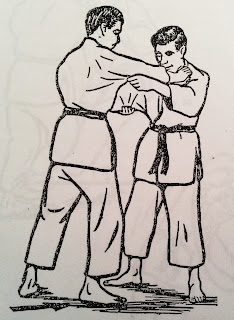De Ashi Bari or De Ashi Hari Explained Properly
De Ashi Bari or De Ashi Hari explained properly
 |
| Stand Tall: Respect and Affect Click Here For More Information |
I'm no Neil Adams nor have I ever really come close to the world or even national championships. The most I have ever achieved is a first place in State championships and I have deliberately chosen to remain a Ni Dan. So I will never claim to be an expert but I have never been able to understand why nobody wants to explain De Ashi Hari (De Ashi Bari) properly. This is quite simple my most favourite throw purely because of its simplicity.
It also holds a special place in my heart because although a good coach would never do so today, - modern teaching techniques have shown that De Ashi Hari as a first throw is not the best - it was the first throw I was taught.
I say simplicity but I don't mean by any means that it is the easiest to learn. Far from it, it requires excellent timing to get it right and lots of practice. But the principle of the throw is totally unambiguous. It is just tripping up your Uke. When It is done correctly with all the timing and precision that lots of practice bring, it is simply beautiful and graceful to watch. To me, it epitomises the Judo principle of "maximum efficiency for minimum effort".
Since it is my favourite throw, I am therefore going to brazenly try to explain it the way I think it should be explained, here in this post.
 |
| De Ashi Bari Fig.1 |
De Ashi Hari Overview
Fig.1 above shows the performance of the throw and I feel confident that it is from looking at this image, or one like it, that most Judoka have learned to do De Ashi Hari. But the image can be deceptive and as a result, most Judoka has learned to do it wrong. That is, the image is not wrong but most people look at it from the wrong perspective.
Most students only look at the top half of the picture and fail to take into consideration the arrow on the ground. Thus the impression that is given, is that the foot goes behind Uke and the kuzushi is to the rear. This is quite incorrect.
De Ashi Hari Foot Movement
Tori's foot should be, more or less, on the side of Uke's foot with the toes raped around the ankle bone and Tori's heal more or less, on the instep of uke. The kuzushi is to the side (Fig.2, 3 & 4).
 | |
|
 | |
|
 | |
|
I say more or less because in the heat of a competition it cannot be expected that Tori should locate their foot exactly but there is no doubt that the position of Tori's foot as I have described, is the most efficient De Ashi Hari.
Allowing your foot to go behind Uke's ankle will tend to result in forcing you to sweep the foot forward instead across the front and between you and your opponent as displayed by the above arrow (Fig.1). The affect being Ko Soto Gari, not De Ashi Hari. If fact, I have seen many Ko Soto Gari mistakenly called De Ashi Bari. Not that it matters in a competition if the throw is successful and scores. After all, a score is a score regardless of what throw it is.
De Ashi Hari Leg Movement
It also needs to be pointed out that Tori should have their leg slightly bent at the knee to allow for their pad of the foot to be fully placed and exposed on the Uke's ankle. This allows for maximum power to be applied to the leg movement
If your leg is straight, not only will you kick you opponent and possibly be disqualified if the referee sees it, but you lose power and efficiency. Not to mention annoying the hell out of you opponent.
De Ashi Hari Arm Movement
As hinted at above, Troi's arm action is to draw Uke's shoulder clockwise to the ground. There should be no rear movement. This is achieved in a number of ways, the steering wheel is the description that I have heard the most. To my mind, however, the best way to achieve the desired action is by drawing Uke's elbow between you and Uke as you sweep (Fig.5, 6 & 7).
 |
| De Ashi Hari Fig.5 |
 |
| De Ashi Hari Fig.6 |
 |
| Fig.7 |
The Gake
The finishing (gake) of the throw is the whole body but particularly the arm that is going between you and Uke is following the flow of the movement of the leg as it is sweept between you and Uke causing Uke to go to the mat (Fig. 7 note the downward thrust that is the natural result of the sideways motion as it reaches the end of the bodies action.).
As I say De Ashi Hari is and elegant and precision throw. I would argue that is is a throw that every Judoka should diligently practice. Even if it is not one of your favourite throws such practice will help you in your appreciation of the beuty of Judo.
Sensai
Richard
 Random thought on Life, Judo Olympics, Judo Self Defense, The Art or Judo Kata, Judo An International Sport. Things that inspire or annoy me or things that I just had to write down.
Random thought on Life, Judo Olympics, Judo Self Defense, The Art or Judo Kata, Judo An International Sport. Things that inspire or annoy me or things that I just had to write down.

No comments:
Post a Comment